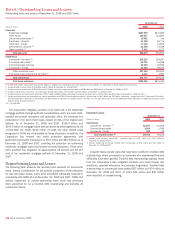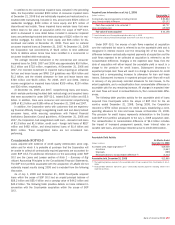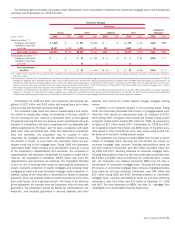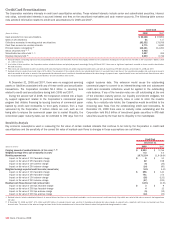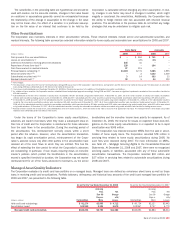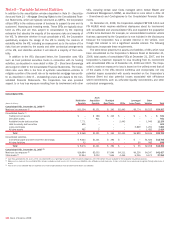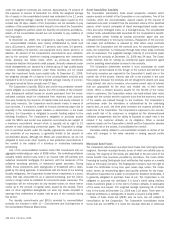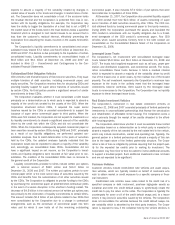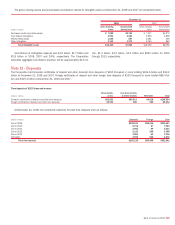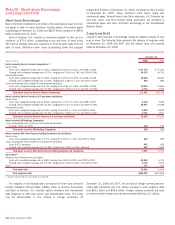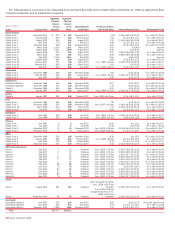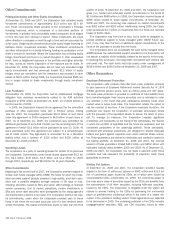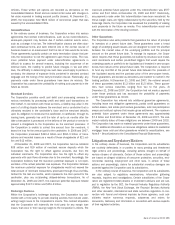Bank of America 2008 Annual Report Download - page 150
Download and view the complete annual report
Please find page 150 of the 2008 Bank of America annual report below. You can navigate through the pages in the report by either clicking on the pages listed below, or by using the keyword search tool below to find specific information within the annual report.
value and is insufficient to cover the vehicle’s obligation to the Corpo-
ration under the credit default swaps.
Asset acquisition vehicles acquire financial instruments, typically
loans, at the direction of a single customer and obtain funding through
the issuance of structured notes to the Corporation. At the time the
vehicle acquires an asset, the Corporation enters into a total return swap
with the customer such that the economic returns of the asset are
passed through to the customer. As a result, the Corporation does not
consolidate the vehicles. The Corporation is exposed to counterparty
credit risk if the asset declines in value and the customer defaults on its
obligation to the Corporation under the total return swap. The Corpo-
ration’s risk may be mitigated by collateral or other arrangements.
Other Vehicles
Other vehicles include loan and other investment vehicles as well as
other corporate conduits that were established on behalf of the Corpo-
ration or customers who wish to obtain market or credit exposure to a
specific company or financial instrument.
Loan and other investment vehicles at December 31, 2008 and 2007
consisted primarily of securitization vehicles, including term securitization
vehicles that did not meet QSPE status, as well as managed investment
vehicles that invest in financial assets, primarily debt securities and
loans. The Corporation determines whether it is the primary beneficiary of
and must consolidate a loan or other investment vehicle based principally
on a determination as to which party is expected to absorb a majority of
the credit risk or market risk created by the assets of the vehicle. Typi-
cally, the party holding subordinated or residual interests in a vehicle will
absorb a majority of the risk. Investors in consolidated loan and other
investment vehicles have no recourse to the general credit of the Corpo-
ration as their investments are repaid solely from the assets of the
vehicle.
Other corporate conduits at December 31, 2008 and 2007 are
commercial paper conduits, which hold primarily high-grade, long-term
municipal, corporate and mortgage-backed securities. The assets held by
these other conduits have a weighted average remaining life of approx-
imately 2.5 years at December 31, 2008. Substantially all of the secu-
rities are rated AAA or AA and some of the bonds benefit from insurance
provided by monolines. The conduits obtain funding by issuing commer-
cial paper to third party investors. At December 31, 2008, the weighted
average maturity of the commercial paper was 15 days. We have entered
into derivative contracts which provide interest rate, currency and a
pre-specified amount of credit protection to the conduits in exchange for
the commercial paper rate. In addition, the Corporation may be obligated
to purchase assets from the conduits if the assets or insurers are down-
graded. If an asset’s rating declines below a certain investment quality as
evidenced by its credit rating or defaults, the Corporation is no longer
exposed to the risk of loss.
During 2008, three monoline insurers were downgraded by the rating
agencies which resulted in the mandatory sale of $1.5 billion of insured
assets out of the conduits. Due to illiquidity in the financial markets at
the time of the sales, the Corporation purchased a majority of these
assets. After subsequent sales to third parties, $1.1 billion of these
assets remain on the Consolidated Balance Sheet and are recorded
within trading account assets at December 31, 2008. The conduits are
QSPEs and, as such, are not subject to consolidation by the Corporation.
In the event that the Corporation is unable to remarket the conduits’
commercial paper such that they no longer qualify as QSPEs, the Corpo-
ration would consolidate the conduits which may have an adverse impact
on the fair value of the related derivative contracts. Derivative activity
related to the other corporate conduits is carried at fair value with
changes in fair value recorded in trading account profits (losses).
Note 10 – Goodwill and Intangible Assets
The following table presents goodwill at December 31, 2008 and 2007,
which includes approximately $4.4 billion of goodwill related to the
acquisition of Countrywide. For more information on the Countrywide
acquisition, see Note 2 – Merger and Restructuring Activities to the
Consolidated Financial Statements.
December 31
(Dollars in millions) 2008 2007
Global Consumer and Small Business Banking
$44,873
$40,340
Global Corporate and Investment Banking
29,570
29,648
Global Wealth and Investment Management
6,503
6,451
All Other
988
1,091
Total goodwill
$81,934
$77,530
The Corporation performed its annual goodwill impairment test as of
June 30, 2008 which indicated some stress in certain reporting units. As
a result of this test and considering the overall market displacement, an
additional impairment analysis was completed at year-end. The Corpo-
ration evaluated the fair value of its reporting units using a combination
of the market and income approach, using a range of valuations to
determine the fair value of each reporting unit. In performing the updated
goodwill impairment analysis the Mortgage, Home Equity and Insurance
Services business failed the first step analysis (i.e., carrying value
exceeded its fair value) and therefore the second step analysis was per-
formed (i.e., comparing the implied fair value of the reporting unit’s
goodwill with the carrying amount of that goodwill). In addition, although
not required, to further substantiate the value of the Corporation’s good-
will balance the second step analysis described above was performed for
the Card Services business as well. As a result of the tests, no goodwill
losses were recognized for 2008. For more information on goodwill
impairment testing, see the Goodwill and Intangible Assets section of
Note 1 – Summary of Significant Accounting Principles to the Con-
solidated Financial Statements.
148
Bank of America 2008


